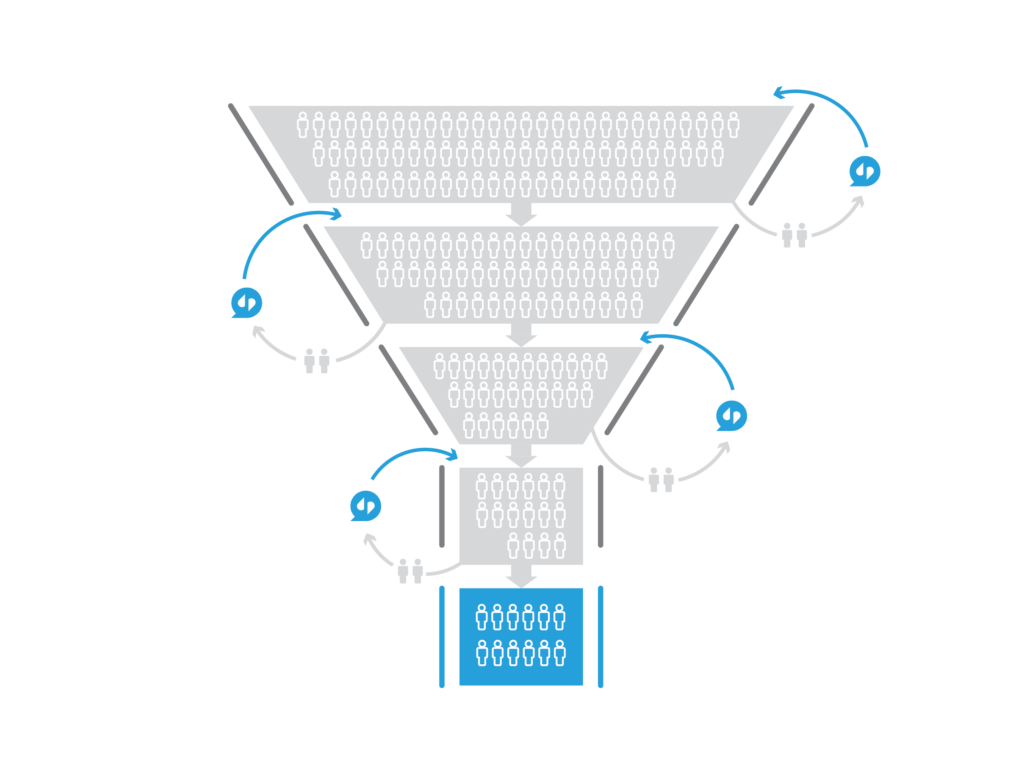If one of the goals of your contact centre is to generate sales for your business, a key challenge to overcome is how you’ll generate leads for your calling team.
The quality of your leads is a major factor in determining the success of your contact centre. Without a consistent supply of relevant people to call, your sales team may struggle to achieve the results you’re looking for.
In this guide, we’ve explained five different lead generation strategies you can use for your outbound call centre. We’ve explained their strengths and weaknesses, as well as how to implement each lead generation method.
1. Inbound leads from your website

Some businesses neglect their website as a lead generation source, for a number of reasons, many of which are quite valid.
Performing search engine optimisation (SEO), and setting up your website to get traffic from Google, does take time. And the other common approach, which is to buy ads from Google, can be very expensive, depending on your industry.
However, in the long run, it pays to invest in setting up your website to generate leads. Even in the most competitive of industries, or industries where very few people search for your type of product, you can still generate leads passively through your website, if it’s set up correctly.
Here are some tips:
- Make it as easy as possible for a lead to submit their details. It’s crucial to eliminate any technical or web design issues that could make a web visitor hesitate to click “submit”. Ensure that the site looks professional, on both desktop and mobile, and have a strong call to action, visible on your website’s top navigation, that visitors can use to submit their details.
- Try to provide as much relevant detail on your website as possible. As well as product pages, you ideally want to have at least a few blog posts on the site as well, explaining industry-relevant concepts in detail. Essentially, to evaluate the relevance of a website for a specific search term, one of the things Google does is assess what your website is about, and what you are knowledgable about. The more helpful, relevant, informative content you include on your website, the more likely Google is to consider you relevant for search terms related to your products and services. This is especially true if your particular page that is a candidate to rank for a given search term contains a good volume of useful, relevant information.
If you’re in a very specific industry, especially a business-to-business (B2B) industry with not a lot of people making Google searches, chances are, SEO will not be extremely competitive. By building a quality website with a good quantity of useful information, you should be able to capture a large proportion of the searches that do take place.
If you’re in a broader industry with a lot of people making Google searches, chances are, SEO will be quite competitive. To overcome this challenge, you want to focus on more specific segments, also known as “long tail keywords” in the SEO world. When creating your website, focus on the more specific types of services or topics that you’re knowledgeable about, which your competitors don’t focus on as much.
As we touched on above, it can take a long time from publishing a website to seeing meaningful volumes of traffic come in. However, in the vast majority of industries, it’s an investment worth making over the long term.
2. Referrals

Chances are, your business already takes advantage of word-of-mouth referrals to drive new customer acquisition. If you provide a great product or service, your customers are going to let their friends and/or family know about it.
However, depending on the nature of your business, it’s often possible to encourage more customer referrals than you are currently getting, and generate leads that your team can get in touch with.
You can do things like:
- Offer discounts for people who refer their friends. This is most effective when your service has a regular fee (rather than being a one-time purchase), because customer A gets the chance to use the product and see its benefits before they refer customer B, and, you have a future bill you can discount for customer A, as their incentive for making the referral. Once customer A provides customer B’s contact details, you can get in touch with them.
- Offer bonuses/extra services for people who refer their friends. This is similar to the above, but rather than discounting the service, you provide a bonus to the customer who makes the referral, depending on the nature of your product/service. For example, free maintenance for a physical product, or free credits for a software product.
- Created tiered reward systems, based on the number of people referred in a given month/quarter.
As well as encouraging existing customers to make referrals, you can also set up something similar with websites, influencers, and blog publishers in your industry – this is known as “affiliate marketing”.
To do this, you create an affiliate programme, and let publishers know about your offer. You might offer $50 per referred customer, or 5% of sales, for example.
Then, if all goes well, publishers will begin referring customers to your business. Typically, they will link to your website, and leads will be captured through one of your forms. Only once the lead has been dialled by your contact centre team, gone through the sales process, and become a paying customer, will you be obligated to pay the publisher.
3. Buying pre-packaged lead data

Many services exist that purportedly give you the ability to buy lists of qualified leads, which you can then begin calling.
The benefit of using this strategy is how quickly you can get your hands on leads that your team can reach out to. Since the lists of leads already exist, you can begin using them immediately, after paying for access.
However, there are a number of downsides to buying lead lists:
- There can be regulatory concerns with this practice, especially to do with GDPR in the EU and the California Consumer Privacy Act (CCPA) in the US. It can be difficult to find a lead list with relevant contacts who have opted in to receive communications.
- You need to ensure that the list contains the right type of people, which may be difficult if you are in a very specific industry. The data may need filtering before it can be used.
- You have no way of knowing whether or not your competitors have used the same lead lists – the good quality leads on the list may have already been contacted by other companies.
- Until you begin dialling, you won’t know whether the data is out of date or not.
Essentially, buying pre-packaged lead data can be a useful way to acquire leads that you can immediately begin calling. However, it’s not always the best way to access good-quality leads.
4. Buying hand-picked lead data

Rather than buying an existing lead list, you could hire someone to produce a custom list of leads.
The main advantage of this approach is it gives you the ability to define exactly the type of people that you want to call. Provided the data collection process is done correctly, you won’t have to worry about having irrelevant leads on your list. You have complete control over which market segments to target.
In saying this, there are some disadvantages to this approach:
- You are limited to publicly-available data, which may severely limit your ability to find the right people for your business to contact if you’re in a business to consumer (B2C) industry. In business to business (B2B) verticals, this isn’t such a big problem, since you can use LinkedIn to find relevant people to contact, based on their job title, and who they work for. The problem is, it’s not possible to use the same approach when looking for B2C data. The advantage of using a reputable list vendor is they might have access to B2C data that is not available publicly.
- This strategy takes a lot of time and effort. You will need to find someone to collect data for you, using a platform such as Upwork. Then, it will take a few weeks or months to collect a sufficient amount of data, depending on the size of your industry. You can speed up the process by hiring multiple people, but this method will still take longer than buying existing lead data.
5. Direct mail

The average person in this day and age is flooded with emails, phone calls, and text messages. For some people, the sheer volume of digital communications we receive makes it hard to grab our attention.
For this reason, direct mail campaigns have been making a bit of a comeback in recent years. Using this strategy, you can generate inbound calls for your agents to answer, rather than collecting phone numbers to make an outbound call to.
You can either:
- Use a direct mail company to send material to a specific number of addresses in a given area. This can be useful if you have a good idea of the types of demographics that buy your product. For example, you might like to target specific postcodes based on the area you service, or the types of people that live there, based on publicly-available demographic data.
- Hire someone to research specific addresses. This strategy is more applicable for B2B businesses. For example, you might like to send mail to HR Managers at insurance companies. In this case, you can collect each contact’s name, as well as their office address, ensuring that your mail ends up on the correct desk.
You also have a lot of choice in deciding what to send people. On the more basic end of the spectrum, you could send a brochure or flyer, as they’re simple to design, and cheap to post. Alternatively, you could put together a piece of long-form material, in the format of an A4 booklet or binder. This would be a more expensive endeavour, but it may be more likely to capture someone’s attention.
Whichever type of media you choose to send, ensure that there is a strong call to action, such as asking the lead to call your phone number to learn more. This massively increases the likelihood that the lead will take the action that you’re looking for.
How to make the most of your lead data

Now that you have some leads to call, it’s important to take a smart approach to getting in contact.
Sometimes, businesses burn through their leads, by overdialling, leading to wasted data. Others fail to dial their leads enough, leading to significant numbers of opportunities being missed.
To get the most from your lead data, you need a consistent, intelligent approach to making customer contact.
Here at contactSPACE, our contact centre software helps a large number of contact centre teams make more efficient, more effective outbound contact. Using contactSPACE, you can:
- Call phone numbers based on the time of day they’re most likely to be answered.
- Attempt a given number at a different time of day, and day of the week, if it wasn’t answered on the first attempt.
- Automatically shelve records after a given number of failed attempts, depending on why they didn’t answer. For example, you might like to immediately remove disconnected numbers from your list, to avoid wasting your agents’ time.
- Rotate the phone number displayed between attempts (your CLID), maximising the chances of a lead picking up the phone.
- Use progressive or predictive dialling, to improve outbound dialling efficiency.
Learn more about contactSPACE Intelligent Outbound.
